
Port Arthur taken from the ship.
Maureen and I attended a talk about Port Arthur and Hobart. At the end of the Port Arthur talk the speaker stated that we would be anchored off shore, because Port Arthur was not a port that could cope with a vessel of our size. In fact, all they could cope with would be small motor boats.
She also mentioned that it would be a 45-minute boat ride from the ship to the shore. At that distance, which I estimated to be about eight to ten miles off shore, I told Maureen that I didn’t think that we would bother going ashore because it could be quite rough for a tender craft (ship’s lifeboats), and as she hated small boats it would not be a particularly pleasant ride.
That evening in the ship’s newsletter the distance (in time) was confirmed and we made plans to remain on the ship.
I was awake early the following morning and I felt the movement of the ship change and looked out of our window. We’d entered sheltered area. I could see land on both sides of the ship so that we were protected from the ocean. As I looked out I could see Port Arthur.
The distance from the shore was nowhere near a forty five minute boat ride, more like fifteen minutes and in fact I timed it and it was twelve minutes from where the Golden Princess anchored.

At once our plans changed, and we dressed for going ashore.
It was a smooth ride in one of the ship’s tenders to the small pier where we stepped ashore.

Just a short walk to the ruins of Port Arthur.
Port Arthur was a prison that was created in 1830 to supply timber for various government projects using convict labour.
In 1833 it changed to become a repeat offenders prison for criminals from all over Australia. The prison was modelled on the Pentonville prison in the UK, which was described as a ‘machine for grinding rogues in to honest men.’
Some of the prisoners left Port Arthur with the skills of a trade, blacksmith, carpenters and shipbuilders. Unfortunately others became broken men.
Around the prison was a community of military and free men with their families, who lived normal lives of parties, sailing for fun and literary evenings. Gardens were created, and children went to school within the settlement.
Port Arthur grew to be an industrial settlement, and by 1840 more than 2000 people, who were a mix of convicts, soldiers and free men lived, and worked. They produced bricks, furniture, clothing, boats and ships.
Transportation from the UK to Tasmania ceased in 1853 and the prison became an institution for the aged, mentally& physically ill convicts, and finally closed in 1877.
Many of the bricks from various buildings were sold off very cheaply to locals who used them to build or expand their own homes. The name of Port Arthur was changed to Carnarvon to erase the hated convict links.
Over the years convict stories drew tourists to the area, and by the early 1920’s some of the remaining buildings had become museums.
 The prison was a building of four levels – ground floor and first floor for ‘prisoners of bad character’, with individual cells for each prisoner. The top floor accommodated 480 better behaved prisoners and the third floor was used as a dining area, recreational area, and school for the prisoners.
The prison was a building of four levels – ground floor and first floor for ‘prisoners of bad character’, with individual cells for each prisoner. The top floor accommodated 480 better behaved prisoners and the third floor was used as a dining area, recreational area, and school for the prisoners.
The prisoners were told that if they behaved they would be rewarded, and moved from the bottom single cells (see single cell photos), to the floor above, still single cells, and so on, until they reached the top floor. If they maintained their reputation as ‘good’ prisoners, they would be allowed the use of the recreational floor.
The picture above, and the one below, is of single cells on the ground floor.
 A plaque can be seen in the above photograph, which I have reproduced below.
A plaque can be seen in the above photograph, which I have reproduced below.


Many Australian consider it a badge of honour to have a transported criminal in their family background. Often people will tell you, with pride, that their forefathers were transported for stealing just a loaf of bread or some other small item, but many where habitual criminals and the stealing of the loaf was the last straw for the magistrate. Many were sentenced to seven years and could have returned to the UK after serving their time, but chose to stay in Australia because they had been given ‘tickets of leave’ for good behaviour during their time as a prisoner, and had created a new life in Australia, and eventually became a free man or woman.
I researched my own family tree and found George Woodland, who was convicted in 1790 at the Old Bailey in London, for stealing a coat. He was sentenced to be transported because he had a string of offences. After spending two years on a prison hulk he sailed from Gravesend (which is on the south bank of the Thames) in 1792 as one of 300 males prisoners in Royal Admiral. The ship finally sailed from Torbay, which is on the southern coast of the England, on the 30th May 1792, and arrived in Sydney on the 02nd October of the same year. I found a picture of the Royal Admiral on the internet.
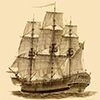 George Woodland is listed on the ship’s manifest as John Woodland, but all other information points to George and John being the same person. (Court records etc).
George Woodland is listed on the ship’s manifest as John Woodland, but all other information points to George and John being the same person. (Court records etc).
One of the seamen on the ship was also named Woodland (coincidence?), but his Christian name was James.
Maybe the clerk who made out the manifest wrote ‘John’ instead of ‘George’, perhaps being influenced by his shipmate’s name i.e James.
The Royal Admiral was 914 gt, 120 feet (36 mtrs) in length, by 38 feet (11.5 mtrs) beam and had about 481 people onboard, which included several children, 49 female convicts, 20 soldiers, a number of free people, about 50 crew and 300 male prisoners.
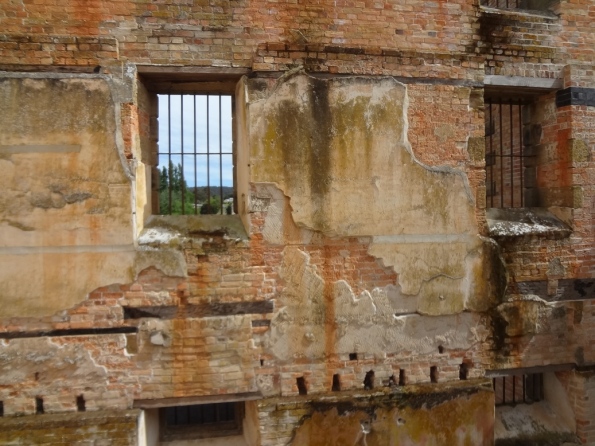 First floor of the prison.
First floor of the prison.
 Second floor – the metal supports that can be seen are to help keep the walls from collapsing during earthquakes.
Second floor – the metal supports that can be seen are to help keep the walls from collapsing during earthquakes.
 Guard Tower – across the road from the prison.
Guard Tower – across the road from the prison.

Many old buildings are missing, but this shows the view down to the water.
The prison is on the left of the picture and the Guard Tower on the right-side of the picture.
 A model of the early ‘town’. If it was real I would be standing at the prison looking inland to the town. The building on the bottom right is the Law Courts, the building on the left with the path is the Commandants House, the area in the middle is the Guard Tower and behind that are the officer’s accommodation.
A model of the early ‘town’. If it was real I would be standing at the prison looking inland to the town. The building on the bottom right is the Law Courts, the building on the left with the path is the Commandants House, the area in the middle is the Guard Tower and behind that are the officer’s accommodation.
 Outside of the Commandant’s home today.
Outside of the Commandant’s home today.
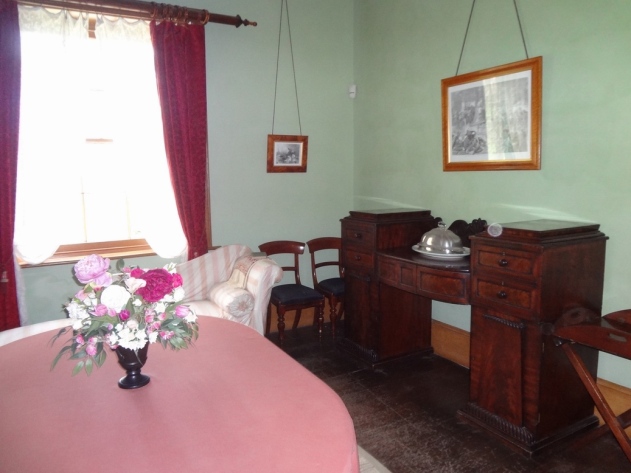 Commandant’s dining room
Commandant’s dining room
 Views of his study
Views of his study

 Kitchen
Kitchen
 I had to take a picture of the recipe.
I had to take a picture of the recipe.
On each of the Princess cruises that Maureen & I have sailed, the ship always has bread and butter pudding on the menu, which I have found to be very good. I have my grandmother’s hand written note book in which she wrote details of various recipes, and one is Bread and Butter pudding, so I must compare the two – the one above and my grandmother’s written in 1896.

A single bedroom in the Commandant’s house.

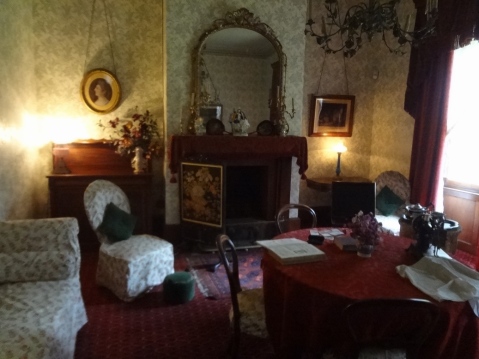 Sitting room
Sitting room
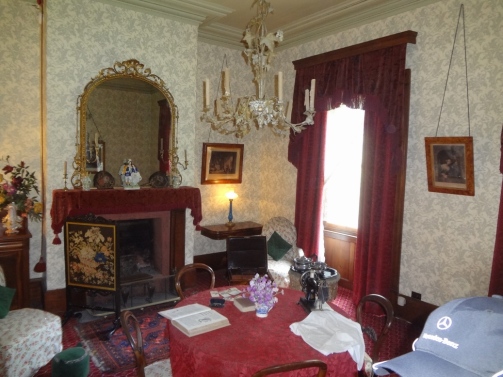
All of the above is history, but below is the sad fact of today’s world.
On the 28th April in 1996, a gunman opened fire on tourists and staff and murdered thirty-five people, wounding a further twenty-three.

At the Broad Arrow Café in Port Arthur, where the killings took place there is now a pool of remembrance, and a place of peace and reflection. The café is no longer there.
 Death has taken its toll, some pain knows no release, but the knowledge of brave compassion shines like a pool of peace.
Death has taken its toll, some pain knows no release, but the knowledge of brave compassion shines like a pool of peace.
 Each leaf (ceramic leaves I think) in the water represents a murdered victim.
Each leaf (ceramic leaves I think) in the water represents a murdered victim.
There was such an outrage that within three months the Australian Federal Government and all Australian States changed the law as to the type guns allowed to be owned by citizens. The Federal Government bought back 640,000 guns and had them melted down. With the political will, and courage, gun control is possible.
The killer was sentenced to 35 life sentences without the opportunity of parole, plus 25 years for the remaining 36 charges on 5 other offences (20 attempted murders, 3 counts infliction of grievous bodily harm, the infliction of wounds upon a further 8 persons, 4 counts of aggravated assault and 1 count of unlawfully setting fire to property.

Twenty years after the event, the pool with the floral tributes near what was the Broad Arrow Café. For more information read this link.
From the memorial we returned to the ship deep in thought. As we left the shore and started the steady chug back across the water I noticed a RAN (Royal Australian Navy) vessel had arrived.


The final tender boat arrives as we prepare to sail.

The gap in the land through which we will sail to the open sea.




 Close enough for me . . .
Close enough for me . . . Peaceful and calm as we enter the Bay.
Peaceful and calm as we enter the Bay.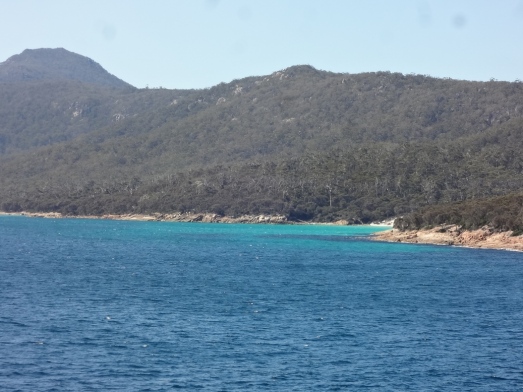
 Virgin beaches
Virgin beaches The entrance through which we passed to enter Wineglass Bay.
The entrance through which we passed to enter Wineglass Bay. Blue on Blue with our wake drifting astern.
Blue on Blue with our wake drifting astern. At peace with the world – our ship is hardly moving.
At peace with the world – our ship is hardly moving.


 The light rail from Port Melbourne to the city takes about fifteen minutes, and costs $7.50 return, if you are a pensioner or $15.00 full fare.
The light rail from Port Melbourne to the city takes about fifteen minutes, and costs $7.50 return, if you are a pensioner or $15.00 full fare. Sunrise over Melbourne as we crept alongside the wharf.
Sunrise over Melbourne as we crept alongside the wharf. The market is a hundred and forty years old (opened in 1878), and is open five days a week – Thursday to Sunday and Tuesday.
The market is a hundred and forty years old (opened in 1878), and is open five days a week – Thursday to Sunday and Tuesday. This was an interesting stall – all the individual flowers are made from recycled wood!
This was an interesting stall – all the individual flowers are made from recycled wood!

 I don’t know how many I touched, just to satisfy my curiosity and to make sure that the flowers were not real!
I don’t know how many I touched, just to satisfy my curiosity and to make sure that the flowers were not real! $5 ‘T’ shirts – I didn’t buy any, but the display was colourful.
$5 ‘T’ shirts – I didn’t buy any, but the display was colourful. Supposedly Australian roads signs, but as I don’t have a bar or ‘den’ I didn’t buy any.
Supposedly Australian roads signs, but as I don’t have a bar or ‘den’ I didn’t buy any. Because our destination was Tasmania I considered buying the Tasmanian Devil sign, but where to hang it at home – all too hard, so didn’t buy anything. I’m a great shopper.
Because our destination was Tasmania I considered buying the Tasmanian Devil sign, but where to hang it at home – all too hard, so didn’t buy anything. I’m a great shopper. Boomerangs – I think they were made in China. . . not sure if they were supposed to work (which I doubt), or if they are just for collecting dust in forgotten drawers at home.
Boomerangs – I think they were made in China. . . not sure if they were supposed to work (which I doubt), or if they are just for collecting dust in forgotten drawers at home.

 Glitter and more glitter, reminded me of various stalls that I ‘d seen in Asia & India.
Glitter and more glitter, reminded me of various stalls that I ‘d seen in Asia & India. This stall had the feel of Japanese cartoon characters – another stall offered Japanese crockery – mainly every day crockery. When I was at sea we used to call in to Nagoya (east coast of Japan), to pick up a cargo of everyday crockery, as well as expensively created porcelain.
This stall had the feel of Japanese cartoon characters – another stall offered Japanese crockery – mainly every day crockery. When I was at sea we used to call in to Nagoya (east coast of Japan), to pick up a cargo of everyday crockery, as well as expensively created porcelain. The above is a sample of Noritake porcelain of Nagoya, from the 1920’s.
The above is a sample of Noritake porcelain of Nagoya, from the 1920’s. Check the hanging item at the centre right of the above picture. Melbourne seems to be big into recycling packing cases or wooden pallets.
Check the hanging item at the centre right of the above picture. Melbourne seems to be big into recycling packing cases or wooden pallets. A close-up of the sculpture . . . unusual, but not to my taste.
A close-up of the sculpture . . . unusual, but not to my taste. Walking down the alley we came to the organic market, which is more my taste.
Walking down the alley we came to the organic market, which is more my taste. I do like chillies – and I was pleased that I’d found something that was ‘made in Australia’ !
I do like chillies – and I was pleased that I’d found something that was ‘made in Australia’ !
 Say cheese!
Say cheese! Stuff this stuff that . . .!
Stuff this stuff that . . .!
 The indoor area of the market, was mainly for the sale of fresh food – wine, fish, meat, bread, everything that you could possibly want, such a shame that this market it is about a thousand kilometres from where Maureen & I live. The colours and the smell of the fresh fruit was a ‘feast’ to the senses.
The indoor area of the market, was mainly for the sale of fresh food – wine, fish, meat, bread, everything that you could possibly want, such a shame that this market it is about a thousand kilometres from where Maureen & I live. The colours and the smell of the fresh fruit was a ‘feast’ to the senses. Nectarines & peaches.
Nectarines & peaches.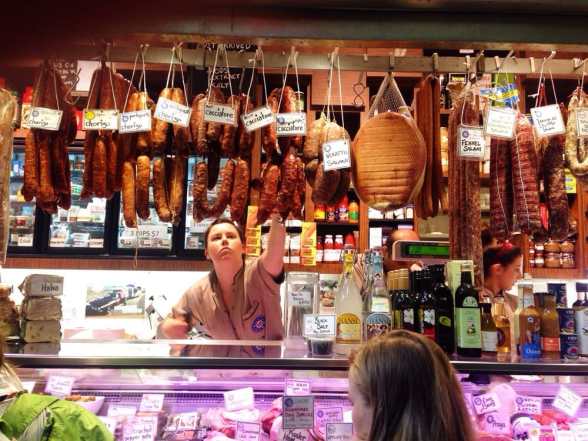 Smoked meat, cold cooked meat, olive oils and more.
Smoked meat, cold cooked meat, olive oils and more.

 For the newer followers I’ve written one book, but it has been published twice. The above two books are the same story – I wrote
For the newer followers I’ve written one book, but it has been published twice. The above two books are the same story – I wrote  I had to buy it, for further background research for my sequel. I’m half way through reading The Fishing Fleet and have forgotten that I should read it for research, because it is such an interesting and entertaining book.
I had to buy it, for further background research for my sequel. I’m half way through reading The Fishing Fleet and have forgotten that I should read it for research, because it is such an interesting and entertaining book. Those of us who were brought up in the ’40’s and 50’s in the UK, always looked forward to Duck Apple night, which was well before Dad hired a TV.
Those of us who were brought up in the ’40’s and 50’s in the UK, always looked forward to Duck Apple night, which was well before Dad hired a TV. I found it ironic that a thousand-year-old ceremony for the souls of the dead in purgatory, should generate a Happy Halloween sign. What’s with the spiders?
I found it ironic that a thousand-year-old ceremony for the souls of the dead in purgatory, should generate a Happy Halloween sign. What’s with the spiders? I’ve never been winked at by an overweight turnip.
I’ve never been winked at by an overweight turnip.
 Was this supposed to be a cowboy?
Was this supposed to be a cowboy? We had company in the dining room. I wasn’t sure if he was a passenger from the last cruise still waiting for his first course.
We had company in the dining room. I wasn’t sure if he was a passenger from the last cruise still waiting for his first course. He was still hanging around when we left.
He was still hanging around when we left. On entering the dining room, we were greeted by, who I thought, was Bat Man, until I realised he was a vampire. At least steak was on the menu!
On entering the dining room, we were greeted by, who I thought, was Bat Man, until I realised he was a vampire. At least steak was on the menu!
 Another odd connection, unless this steward was a
Another odd connection, unless this steward was a 
 Thankfully, this steward was not attending our table.
Thankfully, this steward was not attending our table. Drop your napkin and you meet the strangest people.
Drop your napkin and you meet the strangest people.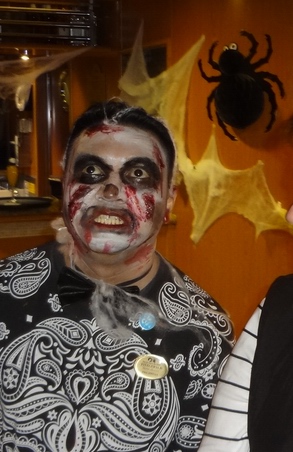 He curdled by cream caramel !
He curdled by cream caramel ! All’s well that ends well.
All’s well that ends well.


 The right-hand side lists the day’s specials – the left-hand side lists the standard offerings.
The right-hand side lists the day’s specials – the left-hand side lists the standard offerings. I hope this picture, which has been enlarged, is clear enough for it to be read.
I hope this picture, which has been enlarged, is clear enough for it to be read. Lunch on the Golden Princess was civilised – the menu changes daily.
Lunch on the Golden Princess was civilised – the menu changes daily.
 Or you could visit the buffet area, which has a wide choice of food. The above two pictures were taken just before noon on a sea day – the buffet opened for lunch at 11.30 am. The pictures show just a small part of the sitting area .
Or you could visit the buffet area, which has a wide choice of food. The above two pictures were taken just before noon on a sea day – the buffet opened for lunch at 11.30 am. The pictures show just a small part of the sitting area . A choice of fish and chip (with salad), or beef burgers, chips & salad – with egg or cheese on the burger, or you could have it just plain. There were various other choices of take away dishes, but the burger & fish are all I can remember. Another ‘stall’ (not shown) offered pizzas, whole or by the slice.
A choice of fish and chip (with salad), or beef burgers, chips & salad – with egg or cheese on the burger, or you could have it just plain. There were various other choices of take away dishes, but the burger & fish are all I can remember. Another ‘stall’ (not shown) offered pizzas, whole or by the slice. To the left of the take away area you can see a bar, so you wouldn’t have far to go to include a beer with the burger & chips – waiter service of course, one is not expected to exert themselves when at sea!
To the left of the take away area you can see a bar, so you wouldn’t have far to go to include a beer with the burger & chips – waiter service of course, one is not expected to exert themselves when at sea! Appetiser
Appetiser Main course
Main course Pudding
Pudding
 Maureen, being a coeliac, receives gluten free meals at lunch and dinner. Each evening during dinner, the Maître d’ would present the following day’s lunch and dinner menus so that Maureen could pick her dishes and they would be produced gluten free.
Maureen, being a coeliac, receives gluten free meals at lunch and dinner. Each evening during dinner, the Maître d’ would present the following day’s lunch and dinner menus so that Maureen could pick her dishes and they would be produced gluten free.

 The balcony was smaller than those that we have experienced on other Princess ships, but as the weather was not ‘sitting out’ weather this was not a problem.
The balcony was smaller than those that we have experienced on other Princess ships, but as the weather was not ‘sitting out’ weather this was not a problem. The view from our cabin before we sailed.
The view from our cabin before we sailed. Also Circular Quay ferry terminal from our cabin.
Also Circular Quay ferry terminal from our cabin.
 A blast form the past, perhaps the last arrival from the 1st Fleet in 1787.
A blast form the past, perhaps the last arrival from the 1st Fleet in 1787. What is now Circular Quay, in 1788.
What is now Circular Quay, in 1788. A piece of history, the Sydney ferry passes the top mast of ‘HMAS Sydney’, the Australian light cruiser that fought and beat the German light cruiser ‘Emden‘ off the Cocos Islands in November, 1914, during WW1.
A piece of history, the Sydney ferry passes the top mast of ‘HMAS Sydney’, the Australian light cruiser that fought and beat the German light cruiser ‘Emden‘ off the Cocos Islands in November, 1914, during WW1. If you wish to know more of ‘HMAS Sydney’ and the ‘Emden’ check this
If you wish to know more of ‘HMAS Sydney’ and the ‘Emden’ check this 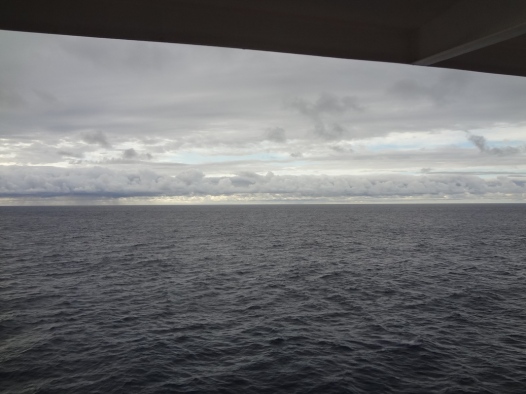 The view from our balcony, after leaving Sydney harbour. I could spend hours just watching the sky change shape – who needs TV?
The view from our balcony, after leaving Sydney harbour. I could spend hours just watching the sky change shape – who needs TV?